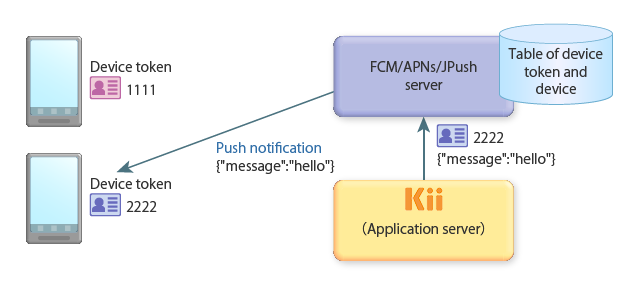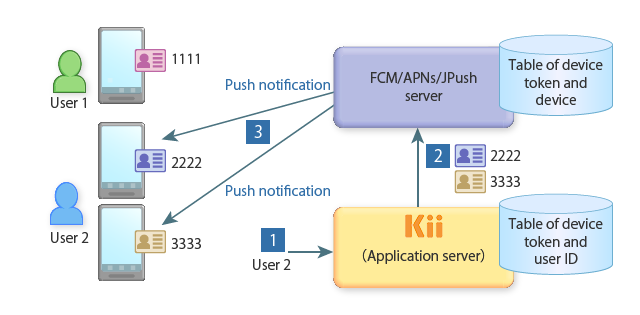How Push Notification Works
This topic explains the relation between Kii Cloud and push notification networks such as FCM.
The content of this topic applies to FCM and APNs. For implementation using MQTT, see MQTT Protocol.
Push notification components
Any of the push notification networks requires the following three components:
-
FCM or APNs server
The server of the service provider such as Google and Apple for push notification.
-
Devices such as smartphones
Devices being used by end users.
-
Application server
Kii Cloud that functions as the application server for push notification.
The push notification networks identify each device by device token. A device token is not a device IMEI but an ID to identify a certain mobile app on a certain device. It is issued by calling libraries of FCM or APNs. The servers of FCM and APNs manage a list of pairs of a device token and an actual device.
When a push notification is sent, the application server calls the server of the target push notification network and passes the push message and the device token of the destination device. The target push notification network sends the message to the device specified by the device token.
A push notification message is a JSON string as shown in the diagram below. The JSON string includes control fields specific to the push notification network in addition to the message for the recipient user.

Push notification in Kii Cloud
The Kii Cloud APIs do not send push notifications to devices but users.
The three types of push notifications of Kii Cloud are sent to users in the following ways:
- A Push to App notification is sent to a user's devices when a bucket subscribed to by the user is updated.
- A Push to User notification is sent to a user's devices when a message is sent to a topic subscribed to by the user.
- A Direct Push notification is sent to a user's devices when the administrator sends a message to the user.
One request for a push notification to a user generates a notification to each of the user's all devices if necessary initialization has been done on each device.
Kii Cloud manages a list of pairs of a user and a device token so that it can send push notifications to users. If a recipient user has multiple devices, Kii Cloud sends multiple requests to the push notification networks.

You cannot use the push notification feature without defining users. If you need to avoid explicit logins, consider implementations using pseudo users and so on.
Request flow
See below for the entire flow that starts with the initialization of the push notification feature and ends with a user's reception of a push notification. Some of them are hidden if the Kii Cloud SDK is used.
A device sends a request to the FCM or APNs server to register the device.
The FCM or APNs server registers the device and issues a device token.
The device calls the push initialization API of the Kii Cloud SDK when a user logs in. The API sends the device token and the user ID to Kii Cloud. These are stored in Kii Cloud as a pair.
An event occurs on Kii Cloud. Using the stored pair of the user ID and device token, Kii Cloud identifies the recipient user's device to send a push notification.
Kii Cloud requests the FCM or APNs server to send a push notification to the target device token.
The FCM or APNs server sends a push message to the device. The device processes the received push message.

Step ![]() where a device token is registered to Kii Cloud is called device installation. The installation needs to be performed when the mobile app is initialized and when the push notification network notifies that the device token has been changed.
where a device token is registered to Kii Cloud is called device installation. The installation needs to be performed when the mobile app is initialized and when the push notification network notifies that the device token has been changed.
Installing a device
A process where a device token is registered to Kii Cloud (![]() in Request flow above) is called device installation.
in Request flow above) is called device installation.
For more information about device installation, see Installing a Device
Structure of the mobile app
See the diagram below for the structure of a native mobile app for Android and iOS that uses the push notification feature.

Include libraries for using FCM or APNs and the Kii Cloud SDK in your mobile app.
The libraries for the push notification network are necessary to receive push notifications and the Kii Cloud SDK is necessary to access Kii Cloud.
Note that the Kii Cloud SDK is independent of the implementation of the push notification feature. If the method for implementing the push notification feature is updated, you do not need to wait for a new version of the Kii Cloud SDK that is compatible with the new method. All you need to do is updating the libraries for the push notification network and the implementation of push notification in your mobile app.